SUMMER 2004 LEADERSHIP PROGRAM FOR TEACHERS
TEACHER OUTREACH (TORCH) WORKSHOPS
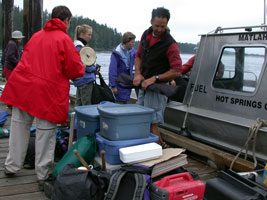
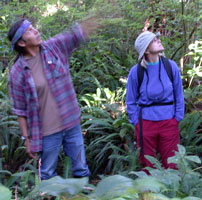
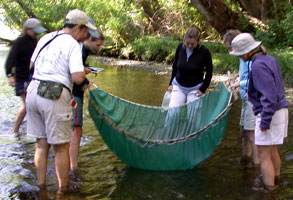
Team loading the water taxi / Traditional knowledge lesson in the rainforest / Assessing salmon streams
"As an Associate Professor of Education at St. Cloud State University, I found the BC TORCH invaluable to myself as a "teacher of teachers," and feel teachers and educators at all levels would benefit through participating in similar experiences. Of particular value to teachers is the manner in which Inquiry Teaching and Learning are emphasized. This emphasis stems from the readings and preparation for the course, but more strongly through the hands-on experiences. For example, our TORCH group participated in a conservation biology research project in collaboration with our First Nations hosts. This project helped solidify the Inquiry approach to teaching and provided a valuable cultural link between our group and our First Nations host family.
Other activities of interest included: learning about how First Nations people utilized their natural resources in a sustainable way, observing the myriad wildlife living close to our camp (wolves, bears, whales & salmon), working with Hesquiaht and Anglo Canadian scientists and educators to learn more about local salmon stream integrity and the inter-tidal ecosystem, and hiking and climbing through the various bio-geological zones of Olympic Peninsula in Washington and the Clayoquot Sound Biosphere Reserve in Canada.
I found the workshop extremely helpful. In my 30 years of teaching and numerous research opportunities it was absolutely the best, most valuable, experience I’ve ever had and the benefit to my students is priceless."
- Professor Gregory Coverdale, St. Cloud State University
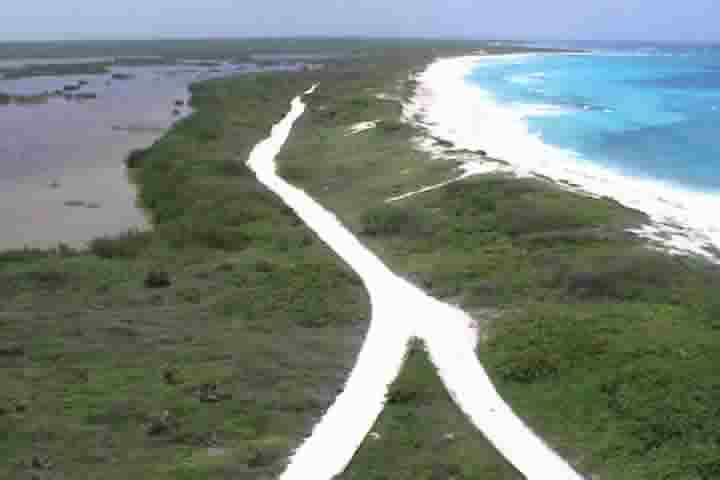
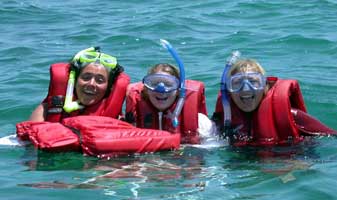
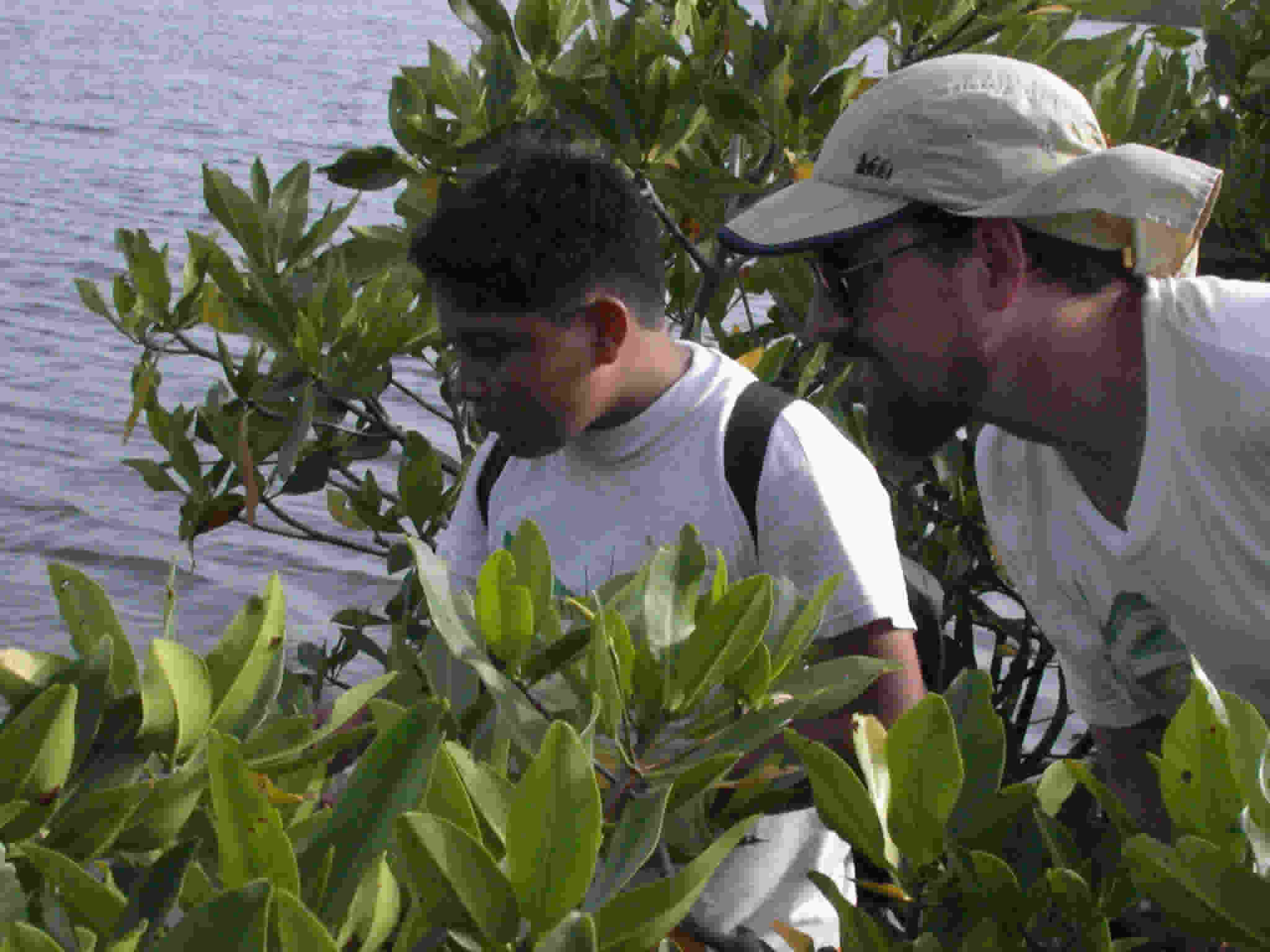
Caribbean lagoon, barrier beach, reef / Snorkel team assessing reef health / Sharing knowledge
1. Field Biology & Field Geology in the Belize Tropical Coastal Ecosystems
Session 1: June 20-27, 2004.
Participant Fee: $1000 plus airfare to Belize City rendezvous. (Partial need-based fellowship may be available).
Credits: 4 graduate-level relicensure hours credits available through Colorado School of Mines (additional $150 fee). 2 sciences graduate credits available through New Mexico Institute of Mining & Technology ($360 fee;fees may rise slightly in 2004).
The Belize Coast Ecosystems are composed of coral reefs, lagoons and tropical forests. In this course we will explore through authentic inquiry-based learning-research activities the incredible coral reefs, forests and wetlands of Belize''s Mayan Coast. Our work is done in cooperation with local Mayan non-profit organizations that have been instrumental in the protection and managament of the region. We will explore and investigate the coastal tropical forests. In addition we will also visit remarkable Mayan ruins. We will be tent-camping and staying in basic cabins. Our days are filled with field work, our evenings include lively powerpoint lectures, films, seminars, text-based discussions of inquiry-based scientific learning, traditional ecological knowledge, expeditionary learning, team development models, global environmental change.
Facilitators:
David Scott Silverberg, Ph.D., Environmental Learning Institute, AZ, silverberg@alum.mit.edu
David Vaughan, M.Sc., Waynflete High School, Portland, Maine.
Anna Gahl Cole, M.Sc., Jemez High School, New Mexico.
Numerous local area experts.
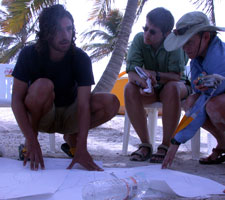
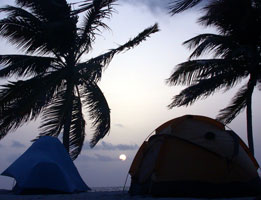
Amigos de Sian Ka'an conservationist explaining protected area strategies in the biosphere reserve / Camp on the Caribbean Sea
Session 1: June 30 - July 7, 2004.
Participant Fee: $1000 plus airfare to Cancun, Mexico rendezvous. (Partial need-based fellowship may be available).
Credits: 4 graduate-level relicensure hours credits available through Colorado School of Mines (additional $150 fee). 2 sciences graduate credits available through New Mexico Institute of Mining & Technology ($360 fee).
The Sian Ka'an Biosphere Reserve is composed of coral reefs, lagoons and tropical forests. In this TORCH we will explore through authentic inquiry-based learning-research activities the incredible coral reefs, forests and wetlands of Mexico's Mayan Coast. Our work is done in cooperation with Amigos de Sian Ka'an, a non-profit organization that has been instrumental in the protection and managament of the region. We will use snorkeling gear for our marine explorations. If the weather turns bad, we will explore and investigate the coastal tropical forests. In addition we will also visit remarkable Mayan ruins and the cinotes (freshwater underground rivers) throughout the area. We will be tent-camping and staying in basic cabins. Our days are filled with field work, our evenings include lively powerpoint lectures, films, seminars, text-based discussions of inquiry-based scientific learning, traditional ecological knowledge, expeditionary learning, team development models, global environmental change.
Facilitators:
David Scott Silverberg, Ph.D., Environmental Learning Institute, AZ, silverberg@alum.mit.edu
David Vaughan, M.Sc., Waynflete High School, Portland, Maine.
Anna Gahl Cole, M.Sc., Jemez High School, New Mexico
Gonzalo Merediz, Program Coordinator, Amigos de Sian Ka'an, Cancun, Quintana Roo, Mexico.
Sam Meacham, Conservation Cenote/Underwater Cave Exploration Geographer
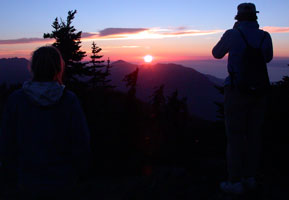
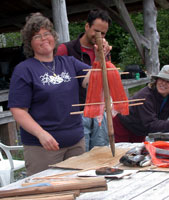

Hurricane Ridge Sunset, Olympic NP / Hesquiaht Karen Charlesen teaching traditional salmon preparation/ Hesquiaht Elder Steven Charlesen teaching Traditional Ecological Knowledge in the rainforest
Session 1: July 14-21, 2004.
Participant Fee: $1000 plus airfare to Seattle rendezvous. (Partial need-based fellowship may be available).
Credits: 4 graduate-level relicensure hours credits available through Colorado School of Mines (additional $150 fee). 2 sciences graduate credits available through New Mexico Institute of Mining & Technology ($360 fee).
Facilitators:
Steven & Karen Charlesen, Hooksum Outdoor School, Hesquiaht Harbor, Clayoquot Sound, B.C.
Sennen Charlesen, Victoria, B.C., Canada
Dennis Morgan, M.Sc., Bamfield, B.C., Canada
David Scott Silverberg, Ph.D., Environmental Learning Institute, AZ, silverberg@alum.mit.edu
In this TORCH we will explore through authentic inquiry-based learning-research activities the incredible coastal temperate rain forests of British Columbia Vancouver Island's "Wild West Coast". July is usually a time of beautiful weather, frequently clear skies. The Clayoquot Sound Biosphere Reserve is composed of the largest intact virgin rainforest in southern British Columbia, inland seaways, fiords and an incredibly rich marine environment. Towering cedar trees, several salmon species, wolves, bears, eagles, grey, humpback and orca whales typify the region. Experimental logging defined by some as sustainable practices are being employed in the area now. We will visit with the First Nations and Anglo-Canadian communities whose lives are fundamentally dependent on the sustainable management of the regions still relatively intact watershed. Our course partners with Hesquiaht First Nations and NGO's in Clayoquot Sound. We will be tent-camping and staying in a traditional Nuu-Chah-Nulth Hesquiaht Longhouse. At the longhouse we will be hosted by the Charelsen family of Hesquiaht First Nations. Our days are filled with field work, our evenings include lively powerpoint lectures, films, seminars, text-based discussions of inquiry-based scientific learning, traditional ecological knowledge, expeditionary learning, team development models, global environmental change.
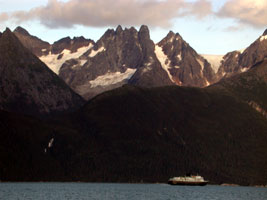
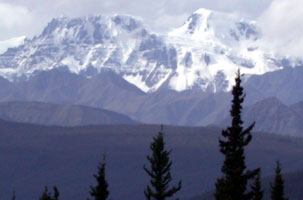
Southeast Alaska Inside Passage / Icefield Ranges, Kluane National Park
Session 1: July 23-August 3, 2004.
Participant Fee: $1300 plus airfare to Bellingham rendezvous and from Anchorage, Alaska. (Partial need-based fellowship may be available).
Credits: 4 graduate-level relicensure hours credits available through Colorado School of Mines (additional $150 fee). 2 sciences graduate credits available through New Mexico Institute of Mining & Technology (additional $360 fee).
Facilitator Contacts:
David Scott Silverberg, Ph.D., Environmental Learning Institute, AZ, silverberg@alum.mit.edu
Allison Butler, M.Sc., Unversity of Alaska - Anchorage
Numerous local area experts
In this course we will explore through authentic inquiry-based learning-research activities the incredible Alaska Inside Pasage and the tundra and taiga ecosystems of interior Yukon's Kluane National Park. August is usually a time of beautiful weather, frequently clear skies. On board the Alaska ferry, we will have lectures, films and learning activities to introduce you to the Alaska's and British Columbia's coastal temperate rainforest. The coastal zone is composed of spectacular glaciated mountain ranges, extensive temperate rainforest, an amazing marine environment. Upon our docking in Haines Alaska, we will travel to the Yukon Interior. The intact Yukon Interior of Kluane National Park is part of the largest international protected area on Earth, over 15 million acres! Taiga forests, and incredibly mammal-rich dry and wet tundra ecosystems. Spruce trees, willows, birch, grizzley bears, black bears, caribou, moose, wolves, wolverine, arctic fox typify the region. We will be tent-camping and staying in basic cabins. Our days are filled with field work, our evenings include lively powerpoint lectures, films, seminars, text-based discussions of inquiry-based scientific learning, traditional ecological knowledge, expeditionary learning, team development models, global environmental change.
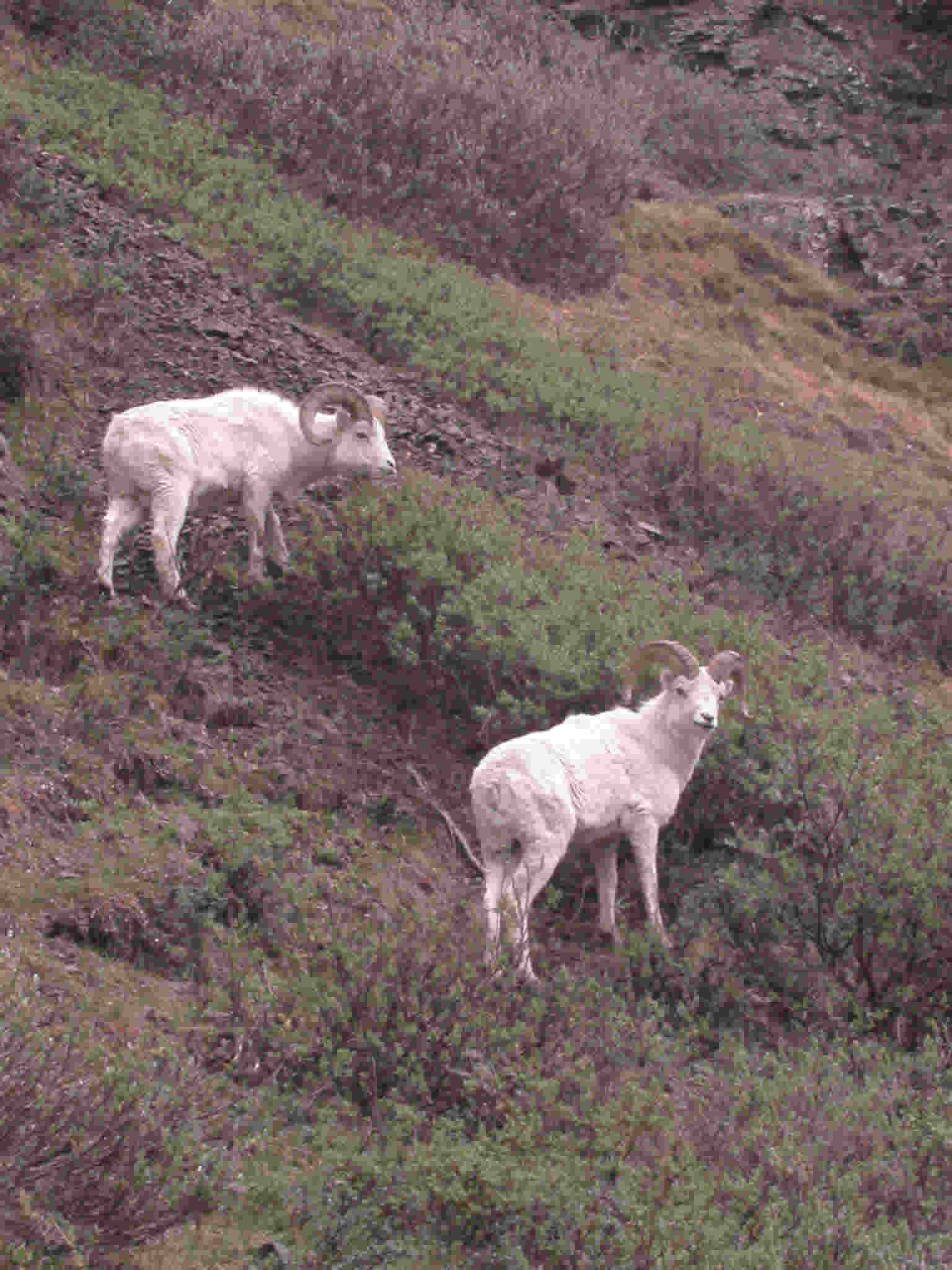
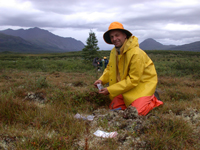
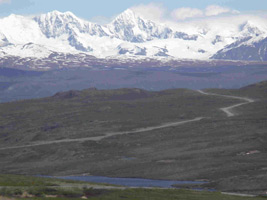
Dall Sheep, Denali NP / Tundra Soil Sampling / Old Denali Road, Alaska Range
Session 1: August 6-13, 2004.
Participant Fee: $1100 plus airfare to Anchorage rendezvous and Fairbanks departure. (Partial need-based fellowship may be available).
Credits: 4 graduate-level relicensure hours credits available through Colorado School of Mines (additional $150 fee). 2 sciences graduate credits available through New Mexico Institute of Mining & Technology (additional $360 fee).
Facilitator Contacts:
David Scott Silverberg, Ph.D., Environmental Learning Institute, AZ, silverberg@alum.mit.edu
Allison Butler, M.Sc., University of Alaska - Anchorage
Numerous local area experts.
In this TORCH we will explore through authentic inquiry-based learning-research activities the incredible tundra and taiga ecosystems of Alaska's "Alaska Range". August is usually a time of beautiful weather, frequently clear skies. The Alaska Range is composed of the highest mountain in North America (Denali), spectacular glaciated mountain ranges, intact Taiga forests, and incredibly mammal-rich dry and wet tundra ecosystems. Spruce trees, willows, birch, grizzley bears, black bears, caribou, moose, wolves, wolverine, arctic fox typify the region. We will visit with the Athabascan and Immigrant-Alaskan communities whose lives are fundamentally dependent on the sustainable management of the region. We will be tent-camping and staying in basic cabins. Our days are filled with field work, our evenings include lively powerpoint lectures, films, seminars, text-based discussions of inquiry-based scientific learning, traditional ecological knowledge, expeditionary learning, team development models, global environmental change.
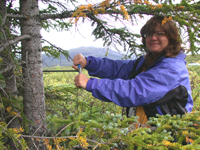
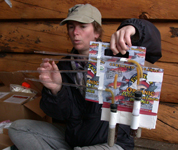
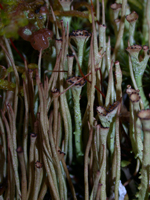
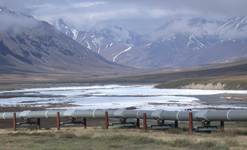
Dendrochronology / Measuring Soil Aerobic Activity / Tundra Detail / Pipeline, Brooks Range
Session 1: August 16-25, 2004.
Participant Fee: $1300 plus airfare to/from Fairbanks rendezvous/departure. (Partial need-based fellowship may be available).
Credits: 4 graduate-level relicensure hours credits available through Colorado School of Mines (additional $150 fee). 2 sciences graduate credits available through New Mexico Institute of Mining & Technology (additional $360 fee).
Facilitator Contacts:
David Scott Silverberg, Ph.D., Environmental Learning Institute, AZ, silverberg@alum.mit.edu
Allison Butler, M.Sc., University of Alaska - Anchorage
Numerous local area experts.
In this TORCH we will explore through authentic inquiry-based learning-research activities the incredible tundra and taiga ecosystems of Alaska's Brooks Range and Arctic National Wildlife Refuge. August is usually a time of beautiful weather, frequently clear skies. The Brooks Range is composed of the most northern mountains in North America, spectacular glaciated mountain ranges, and incredibly mammal-rich dry and wet tundra ecosystems. Grizzley bears, black bears, caribou, moose, wolves, wolverine, arctic fox typify the region. We will be tent-camping and staying in basic cabins. Our days are filled with field work, our evenings include lively powerpoint lectures, films, seminars, text-based discussions of inquiry-based scientific learning, traditional ecological knowledge, expeditionary learning, team development models, global environmental change.